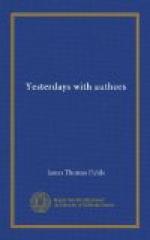“As you know you and I mutually desire to see one another, I hoped that this day our wishes would have met, and brought you hither. And this for the very reason which possibly might hinder your coming, that my poor mother is dead. I thank God, her death was as easy as her life was innocent; and as it cost her not a groan, or even a sigh, there is yet upon her countenance such an expression of tranquillity, nay, almost of pleasure, that it is even amiable to behold it. It would afford the finest image of a saint expired that ever painting drew; and it would be the greatest obligation which even that obliging art could ever bestow on a friend, if you could come and sketch it for me. I am sure, if there be no very prevalent obstacle, you will leave any common business to do this; and I hope to see you this evening, as late as you will, or to-morrow morning as early, before this winter flower is faded. I will defer her interment till to-morrow night. I know you love me, or I could not have written this; I could not (at this time) have written at all. Adieu! May you die as happily!”
Several eminent artists of that day painted the likeness of Pope, and among them Sir Godfrey Kneller and Jervas, but I like the expression of this one by Richardson best of all. The mouth, it will be observed, is very sensitive and the eyes almost painfully so. It is told of the poet, that when he was a boy “there was great sweetness in his look,” and that his face was plump and pretty, and that he had a very fresh complexion. Continual study ruined his constitution and changed his form, it is said. Richardson has skilfully kept out of sight the poor little decrepit figure, and gives us only the beautiful head of a man of genius. I scarcely know a face on canvas that expresses the poetical sense in a higher degree than this one. The likeness must be perfect, and I can imagine the delight of the Rev. Joseph Spence hobbling into his presence on the 4th of September, 1735, after “a ragged boy of an ostler came in with a little scrap of paper not half an inch broad, which contained the following words: ’Mr. Pope would be very glad to see Mr. Spence at the Cross Inn just now.’”




